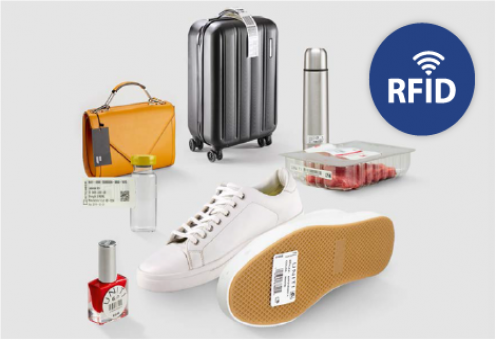
A quick introduction to RFID
RFID technology was originally developed for military purposes in the Second World War however over the last 15 years it has become an essential tool for asset identification and tracking and is used across a huge range of industries and sectors.
How does RFID work
RFID technology relies on an RFID tag/label and RFID reader. An RFID tag contains a microchip and antenna that stores and transmits data which is related to the item it is attached to. The RFID tag reader communicates with the tag via radio signals and receives the tag’s data. This data may then be forwarded to a business’ digital database and stored for a multitude of purposes, such as inventory management.
Types of RFID tag
The two main types of RFID tag are called Passive RFID tags and Active RHID tags
1) A passive RFID tag does not have a battery and is only powered by the signals emitted from an RFID reader. When compared to active RFID tags, these tags are lower cost, have a longer life expectancy, are smaller but have a shorter reading range.
2) An active RFID tag contains a battery and unlike a passive RFID tag it can actively transmit signals to an RFID reader. These tags are more expensive than passive RFID tags but they can transmit data in real time and the data can be read at a greater range compared to passive tags.
The use of passive RFID tags or active RFID tags depends on the specific business requirements,
RFID frequency options
When deciding what RFID system is suitable, the frequency of the RFID is an essential consideration, as this determines what distance you can read the tags from.
There are three main frequency options:
Low Frequency (LF) - LF RFID systems operate at 120KHz to 150KHz, this enables readings from short distances only, no more than 10cm away. Passive tags are often used here. Used in access control systems & animal tracking
High Frequency (HF) - HF RFID systems operate around 13.56MHz, this enables readings from around 30cm. Passive tags are often used here. Used in ticketing and payment systems.
Ultra-high frequency (UFH) - UHF RFID systems operate from 860MHz to 960MHz, this enables readings from up to five or six metres away and for active tags up to 100m away. Passive and active tags are often used here. Used for supply chain and inventory management.
Implementing an RFID solution
The benefits of an RFID system are potentially huge, essential to reaping the benefits of an RFID solution is high quality RFID tags and labels. We supply RFID tags and labels suitable for a range of print methods.
If you would like more information on how RFID can work for you, please don’t hesitate to contact our RFID specialists on 0800 085 8850 or info@systemsprintmedia.co.uk